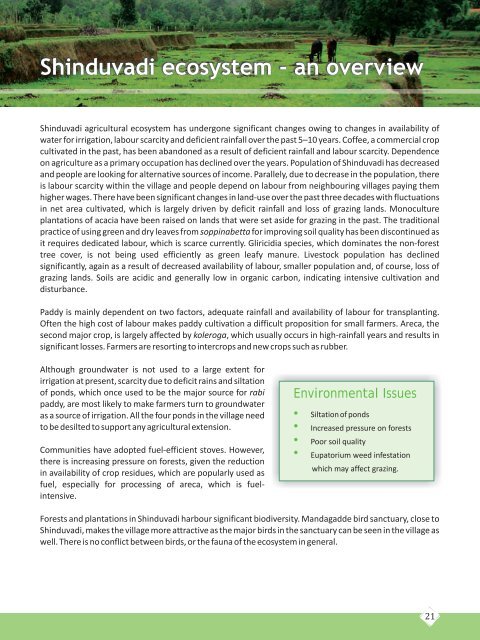2007 - Centre for Ecological Sciences - Indian Institute of Science
2007 - Centre for Ecological Sciences - Indian Institute of Science
2007 - Centre for Ecological Sciences - Indian Institute of Science
- No tags were found...
Create successful ePaper yourself
Turn your PDF publications into a flip-book with our unique Google optimized e-Paper software.
Shinduvadi ecosystem - an overviewShinduvadi agricultural ecosystem has undergone significant changes owing to changes in availability <strong>of</strong>water <strong>for</strong> irrigation, labour scarcity and deficient rainfall over the past 5–10 years. C<strong>of</strong>fee, a commercial cropcultivated in the past, has been abandoned as a result <strong>of</strong> deficient rainfall and labour scarcity. Dependenceon agriculture as a primary occupation has declined over the years. Population <strong>of</strong> Shinduvadi has decreasedand people are looking <strong>for</strong> alternative sources <strong>of</strong> income. Parallely, due to decrease in the population, thereis labour scarcity within the village and people depend on labour from neighbouring villages paying themhigher wages. There have been significant changes in land-use over the past three decades with fluctuationsin net area cultivated, which is largely driven by deficit rainfall and loss <strong>of</strong> grazing lands. Monocultureplantations <strong>of</strong> acacia have been raised on lands that were set aside <strong>for</strong> grazing in the past. The traditionalpractice <strong>of</strong> using green and dry leaves from soppinabetta <strong>for</strong> improving soil quality has been discontinued asit requires dedicated labour, which is scarce currently. Gliricidia species, which dominates the non-<strong>for</strong>esttree cover, is not being used efficiently as green leafy manure. Livestock population has declinedsignificantly, again as a result <strong>of</strong> decreased availability <strong>of</strong> labour, smaller population and, <strong>of</strong> course, loss <strong>of</strong>grazing lands. Soils are acidic and generally low in organic carbon, indicating intensive cultivation anddisturbance.Paddy is mainly dependent on two factors, adequate rainfall and availability <strong>of</strong> labour <strong>for</strong> transplanting.Often the high cost <strong>of</strong> labour makes paddy cultivation a difficult proposition <strong>for</strong> small farmers. Areca, thesecond major crop, is largely affected by koleroga, which usually occurs in high-rainfall years and results insignificant losses. Farmers are resorting to intercrops and new crops such as rubber.Although groundwater is not used to a large extent <strong>for</strong>irrigation at present, scarcity due to deficit rains and siltation<strong>of</strong> ponds, which once used to be the major source <strong>for</strong> rabipaddy, are most likely to make farmers turn to groundwateras a source <strong>of</strong> irrigation. All the four ponds in the village needto be desilted to support any agricultural extension.Communities have adopted fuel-efficient stoves. However,there is increasing pressure on <strong>for</strong>ests, given the reductionin availability <strong>of</strong> crop residues, which are popularly used asfuel, especially <strong>for</strong> processing <strong>of</strong> areca, which is fuelintensive.Environmental IssuesSiltation <strong>of</strong> pondsIncreased pressure on <strong>for</strong>estsPoor soil qualityEupatorium weed infestationwhich may affect grazing.Forests and plantations in Shinduvadi harbour significant biodiversity. Mandagadde bird sanctuary, close toShinduvadi, makes the village more attractive as the major birds in the sanctuary can be seen in the village aswell. There is no conflict between birds, or the fauna <strong>of</strong> the ecosystem in general.21
















